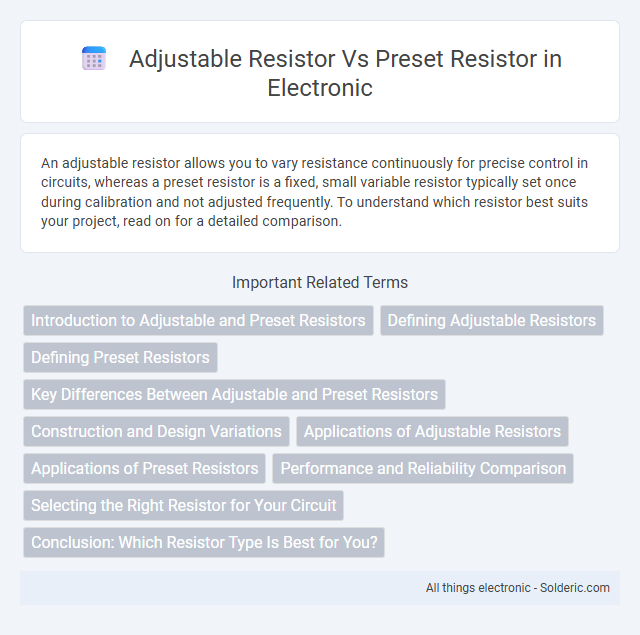An adjustable resistor allows you to vary resistance continuously for precise control in circuits, whereas a preset resistor is a fixed, small variable resistor typically set once during calibration and not adjusted frequently. To understand which resistor best suits your project, read on for a detailed comparison.
Comparison Table
| Feature | Adjustable Resistor | Preset Resistor |
|---|---|---|
| Definition | Variable resistor designed for regular adjustments. | Small, fixed resistor for one-time setting or calibration. |
| Adjustability | Continuously adjustable during operation. | Adjusted once during assembly or calibration. |
| Usage | Circuit tuning, volume controls, and dimmers. | Factory calibration and fine-tuning circuits. |
| Size | Generally larger for ease of manual adjustment. | Compact, often surface-mount size. |
| Cost | Higher cost due to adjustability and design. | Lower cost, simple construction. |
| Durability | Designed for frequent rotation; moderate wear. | Minimal mechanical stress; high stability. |
| Resistance Range | Wide range, typically from ohms to megaohms. | Limited range preset values. |
Introduction to Adjustable and Preset Resistors
Adjustable resistors, also known as potentiometers or rheostats, allow variable resistance control through a movable wiper, making them ideal for tuning circuits and adjusting signal levels. Preset resistors, or trimmers, are compact, fixed-setting resistors designed for calibration and fine-tuning during manufacturing or maintenance. Your choice between these components depends on whether you need frequent adjustment or a one-time precise resistance setting.
Defining Adjustable Resistors
Adjustable resistors, also known as potentiometers or trimmers, allow for continuous variation in resistance to fine-tune circuit performance. Preset resistors are a type of adjustable resistor designed for occasional adjustment during calibration, typically offering smaller size and limited adjustment range. Your choice depends on whether you need frequent resistance changes or a one-time precise setting.
Defining Preset Resistors
Preset resistors, also known as trimmer resistors, are small, adjustable components designed for fine-tuning circuits during calibration or testing phases. Unlike standard adjustable resistors, preset resistors are intended to be set once or infrequently, offering stable resistance values with minimal mechanical movement. Choosing the right preset resistor ensures precision in your electronic device's performance and long-term reliability.
Key Differences Between Adjustable and Preset Resistors
Adjustable resistors offer multiple turns or continuous adjustment, allowing precise tuning of resistance values during operation, whereas preset resistors are single-turn devices designed for initial calibration before being fixed. Adjustable resistors typically feature a knob or screw for easy on-the-fly resistance variation, while preset resistors require a screwdriver for one-time or infrequent adjustments. In terms of applications, adjustable resistors are ideal for circuits needing regular resistance changes, while preset resistors suit situations requiring stable, rarely altered resistance settings.
Construction and Design Variations
Adjustable resistors typically feature a rotary or slider mechanism with a resistive track and a wiper that moves to vary resistance, allowing continuous adjustment across a wide range. Preset resistors, also known as trimmer potentiometers, are usually small, compact devices with a single-turn or multi-turn screw adjustment designed for infrequent settings and fine-tuning during calibration. The construction difference lies in the durability and precision required; adjustable resistors are built for regular use and ease of handling, while preset resistors emphasize stable, low-profile designs for minimal space and limited adjustment cycles.
Applications of Adjustable Resistors
Adjustable resistors are widely used in electronic circuits for tuning and calibration purposes, such as setting bias currents, adjusting signal levels, and controlling voltage. Common applications include volume controls in audio equipment, tuning circuits in radios, and sensitivity adjustments in sensors. Their ability to be precisely varied makes them essential for prototyping and dynamic adjustment in complex devices.
Applications of Preset Resistors
Preset resistors are primarily used in calibration and fine-tuning circuits where precise resistance adjustment is required during manufacturing or servicing. Common applications include setting bias currents in amplifiers, adjusting frequency response in oscillators, and calibrating measurement instruments. Their ability to be adjusted once and then remain stable makes them ideal for maintaining consistent performance in electronic devices.
Performance and Reliability Comparison
Adjustable resistors offer greater precision and versatility in tuning circuit performance, enabling fine resistance adjustments during operation, which enhances system calibration and stability. Preset resistors, designed for one-time or infrequent adjustments, provide robust reliability with minimal drift over time due to their fixed setting, making them ideal for consistent performance in static applications. Performance degradation in adjustable resistors may occur under mechanical stress or frequent adjustments, whereas preset resistors maintain stable resistance values, ensuring long-term reliability in controlled environments.
Selecting the Right Resistor for Your Circuit
Choosing the right resistor for your circuit depends on adjustability needs and precision. Adjustable resistors, such as potentiometers and rheostats, allow fine-tuning of resistance in real-time, ideal for calibration and variable control applications. Preset resistors, or trimmer potentiometers, offer fixed adjustment during initial setup, providing stable and reliable resistance values for long-term circuit performance.
Conclusion: Which Resistor Type Is Best for You?
Adjustable resistors offer greater flexibility and control for fine-tuning circuit performance, while preset resistors provide a cost-effective, stable solution for fixed resistance needs. Your choice depends on whether you require frequent adjustments or a reliable, consistent value in your application. For projects demanding precision and adaptability, adjustable resistors are best, whereas preset resistors suit designs prioritizing simplicity and stability.
adjustable resistor vs preset resistor Infographic

 solderic.com
solderic.com